Turn Your Adobe Connect Room into a cMOOC
Massive Open Online Courses (MOOCs) have become popular in the last decade. In 2012, when MOOCs appeared broadly, only 1.2 million students participated in these online courses. By the end of 2016, 58 million students participated in 6,850 courses through 700+ universities (and other organizations). Like I said, popular. Immensely popular.
So, what exactly are MOOCs?
A MOOC is “a model for delivering learning content online to any person who wants to take a course, with no limit on attendance.” The goal, on the most basic level, is to make academic or expert knowledge available to the masses.
Some MOOCs are free. Others cost money, but even if there is a cost, with it open to the masses the fee will pale in comparison to standard tuition for similar private courses. Many of the free courses are offered by Universities. These schools justify covering the cost by using the data collected to refine teaching practices.

MOOCs represent one of the most transformational mediums in online learning. And it’s value is incredible. People love the prospect of learning for free or at a discounted price.
More importantly, MOOCs have the potential to spread knowledge in a way never possible before in human history, as was noted in a Forbes article. It represents one of the most democratizing developments of the 21st century.
What people don’t realize is that there are two types of MOOC models: cMOOC & xMOOC. And the difference is significant.
cMOOC vs. xMOOC
Why are there two types of MOOCs? Well, as I noted above, the most basic goal of a MOOC is to make expert or academic knowledge available to the average person in the course format. But the initial concept for MOOCs extended beyond that.
As an extension of the Open Educational Resources movement, MOOCs arose not only to provide knowledge but to bring together interested participants. The hope was to create open education in a collaborative environment to encourage communal learning.
What I just outlined reflects the cMOOC model. And it was this model that first appeared.
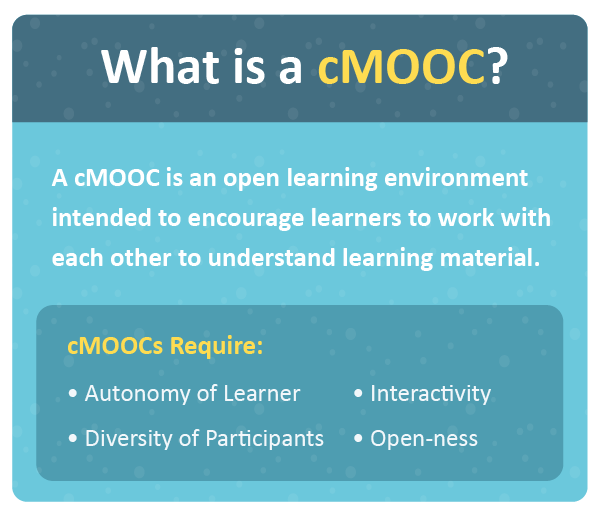
The “c” stands for “connectivist.” Connecting eager and interested learners with experts to collaboratively approach learning topics is the end goal for any cMOOC. The idea is to “come upon” knowledge, to reach conclusions that emerge from group discussions.
There are a few essential characteristics of a cMOOC:
Learners select a topic and help define expectations for course structure.
-
Diversity of Participants/Tools
Learners’ understanding of topics will range; the tools used will be various.
Lecture and presentation must be complemented by group interactions and discussion.
Content, access, assessments and conversations are open.
The other type of MOOC is the xMOOC. While the siblings aren’t complete opposites, they are different. xMOOCs are much more like the lecture halls you see in universities. An instructor presents on a topic, and students will engage each other in online forums after the sessions. Typically, it’s this format in which free courses are offered.
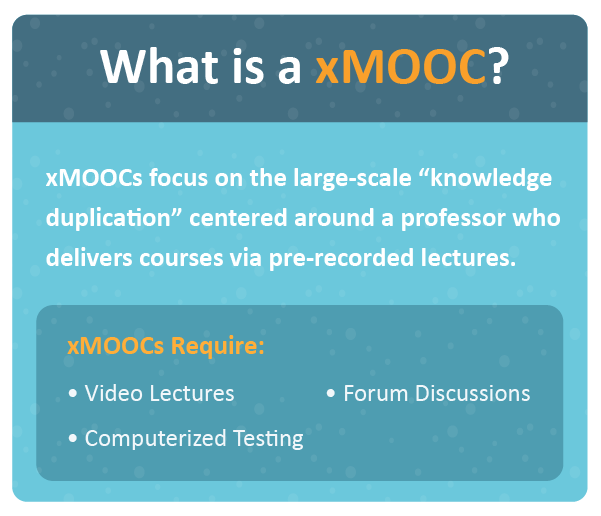
Here are some practices and aspects common to xMOOCs:
Lectures are recorded before a session and watched by learners.
Learners interact after the lecture in a forum setting. The instructor is not always involved in these forums.
Learners are assessed through tests and quizzes.
Most of the MOOCs we see are xMOOCs. Most of the larger schools (particularly in the Ivy League) offer xMOOCs. Some businesses, like the World Bank & Khan Academy, also offer free courses through xMOOCs.
The xMOOC model is simply more viable than the cMOOC. It’s easier to organize courses in xMOOCs, and the costs can be more easily justified or recouped. If nothing else, it’s easier to ascribe value to a xMOOC, as universities don’t have to wonder what the result will be.
xMOOCs, though, don’t capture the original spirit of the MOOC. Their content is predetermined, the discussions are limited and secondary, and the conclusions are defined by the teacher.
Don’t get me wrong. xMOOC instructors are experts in their field, spending their adult lives understanding their subject. So, you know the information is very valuable.
The MOOC spirit, though, isn’t just to bring people together to learn. It’s about bringing people together so they can actively learn, collaborate and discuss – to make the topic more meaningful to the individual participants. And hopefully reach an interesting, shared conclusion.
This brings up an interesting question: Are cMOOCs a possible option to make online learning and training more important to participants?
cMOOCs as a Rich Learning Medium
In the 21st century, we’ve pretty much flipped the model for learning on its head. Instead of focusing on rote learning (or the emphasis on the memorization of learning materials), we’ve come to believe that if learning materials can be made meaningful to learners, they are more likely to retain information.
Meaningful learning has had an observed impact on:
- Productivity
- Trust
- Information Sharing
- External Communication
To change learning from rote to meaningful, learners have to be able to engage, interact with, and appreciate the content on a much more intimate level. Enter the cMOOC.
A cMOOC could be used in conjunction with traditional online learning and training. A virtual space provided for learners to further discuss and debate materials from other lessons with a moderator/instructor on-hand. You’re giving them the chance to engage each other and the content more deeply.

Can you imagine it? Students (or employees) delving deeper into topics, debating with each other. All the while they’re coming to understand the material better. Glorious!!!
There are a few challenges: The cost and the medium. It’s expensive facilitating any MOOC. Then try justifying that expense if you can’t assure stakeholders what the result will be.
Pair this with the problem that cMOOCs require a very interactive, live, virtual space…and it may seem untenable.
We have a solution: Use an Adobe Connect rooms for cMOOCs. (Keep reading to learn how!)
Using Adobe Connect Rooms as a cMOOC
Adobe Connect rooms operate like little virtual classrooms. And Adobe Connect offers many tools and features to help users collaborate and converse efficiently. Interactivity is at a premium, while the cost is relatively low.
Adobe Connect rooms all share features across licensing tiers, so you don’t have to worry if you’re getting gypped on poll, chat, file share or breakout room features. Also, large numbers of people attend even in an average room.
To help you better imagine how it would work, I’ve outlined some features and strategies that could be used to transform your Adobe Connect room into a cMOOC.
Adobe Connect Room Features for cMOOCs
Here are the tools that can help you create a cMOOC in your Adobe Connect room.
Adobe Connect, like all web conferencing platforms, offers screen sharing capabilities. The “Share Pod” allows you to do many things. Of course, there’s sharing your desktop. Files and videos can also be uploaded for sharing. And the pod doubles down on features, including a whiteboard.
The best part is that everything you share can be annotated. If you’re screen sharing, all you have to do is click the little “Pause & Annotate” button. The image is captured and ready to be marked up!
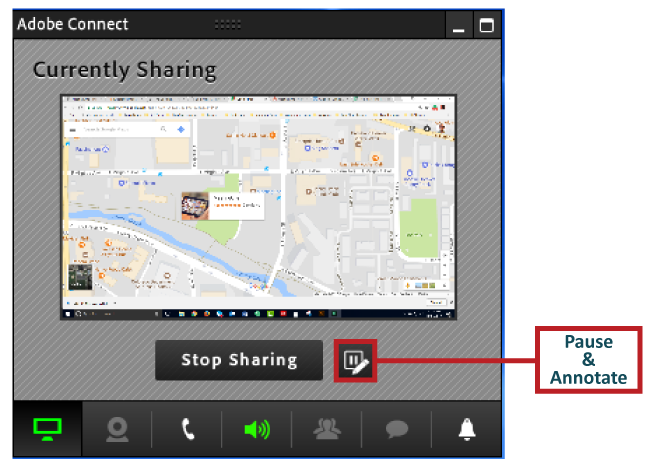
Yep, that includes videos!
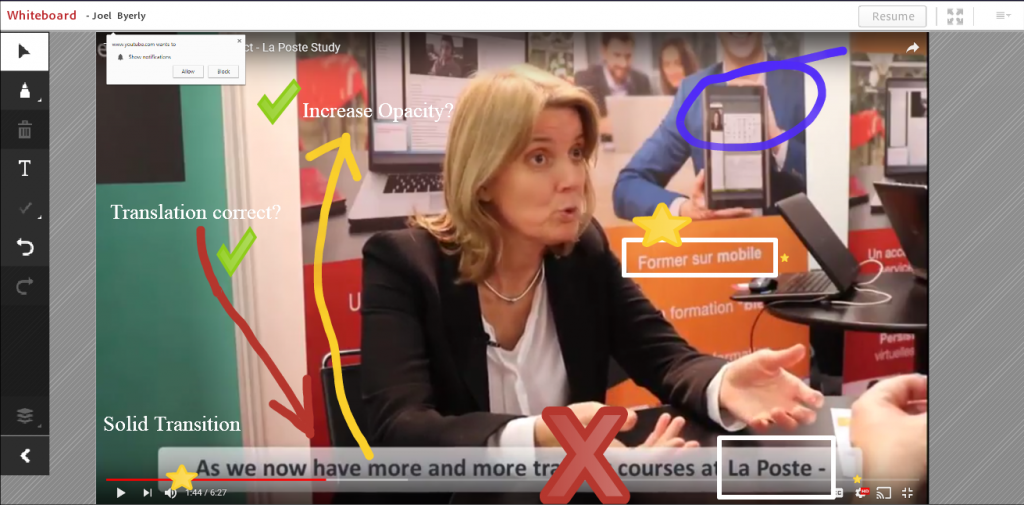
We’re talking about immediate engagement with the material. This type of functionality makes it possible to initiate the conversations that define cMOOCs.
But it doesn’t stop there!
Every Adobe Connect room comes equipped with a pod that allows you to share files: The File Share pod. If granted the right, any learner can place a relevant document in the pod for everyone to download.
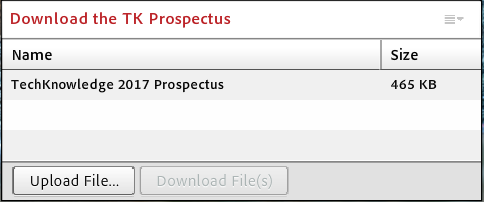
Pair the File Share with the ability to upload documents into the Share Pod quickly, and you can facilitate conversations with supplementary materials on the fly! That certainly encourages communal discussions.
Polls might seem like an odd tool to highlight. But polls are great for many reasons – particularly when you poll in Adobe Connect.
First of all, polls can get people readily engaged. They give everyone an opinion and voice. Secondly, Adobe Connect polls can either be multiple choice, multiple response, or open answer. As a result, people have expanded opportunities to state their thoughts.
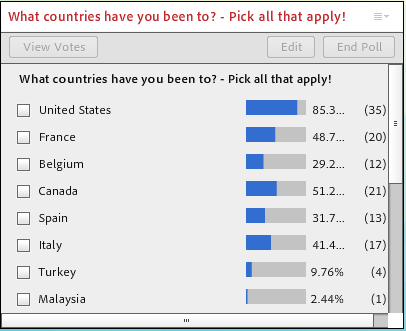
Lastly, polls can help you get a sense of where a conversation should go. While we want cMOOC talks to be open and fluid, structure is still required. You could use a multiple choice to note various topics that could be discussed.
Based on the feedback, you could focus the conversation in one direction or another. You’ve just narrowed the topic without discouraging engagement.
Chats are like polls: They provide participants a way to communicate (without clogging up the airways).
In Adobe Connect, users can change their font color and size. Doing so gives each person a way to present their thoughts.

Chats can also be explored from Adobe Connect and distributed like notes after a session.
A cMOOC without a chat is like a car without the wheels. Your conversations aren’t going to get far.
Adobe Connect Room Strategies for cMOOCs
This functionality is truly unique to Adobe Connect. Most other virtual classroom platforms limit the number of cameras you can have running at any one time. Adobe Connect offers UNLIMITED webcams.
You can have as many webcams running as your bandwidth can support. Allowing participants to use their webcams freely helps to encourage conversation.
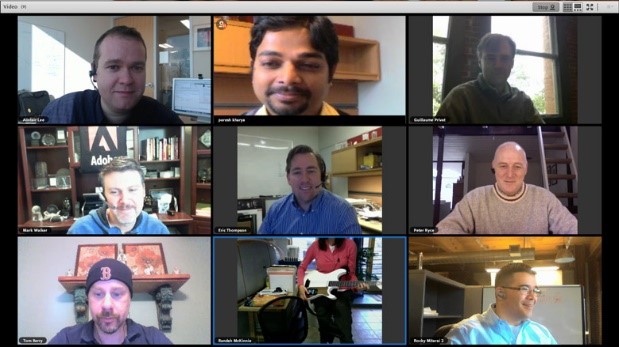
Adobe Connect webcams can also be displayed in two ways: Filmstrip or Grid. You should use the film strip option if you have one speaker you want to be featured. Or, you can go with the grid if you want the conversation to be entirely open.
-
Multiple Layouts/Easy Transitions
Adobe Connect rooms come with unlimited Layouts. A layout is just a virtual space that can be custom designed to meet your needs. So, you can create, for example, one layout that features a large screen share to introduce topics. Your second layout could offer file shares, chats, and polls to help determine the direction of the conversation. And your third: Only webcams.
It’s effortless to move between layouts. You just select the layout you want by clicking on it the Layout Column.
Transitioning between layouts is another way to move conversations forward and provide some structure.
Pooling large numbers of people together to participate in group conversations depends on one thing: Being able to hear and understand each other!
Key to making this happen is to integrate telephony into your room. Audio integration allows participants to use VoIP or their phone to listen and talk.
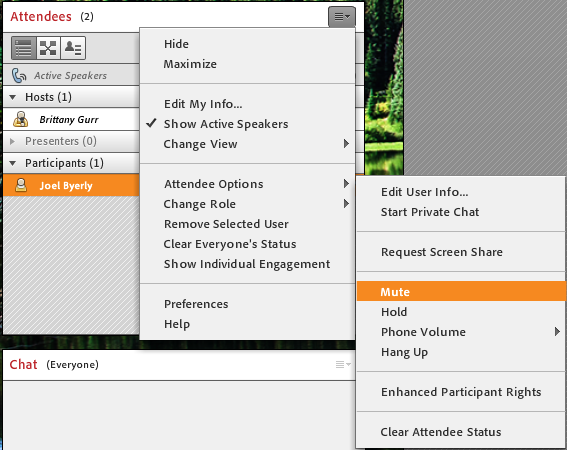
And if you go with a provider like MeetingOne, you get all sorts of extra goodies. Now, the goal is to have open conversations. But there may be the occasion when someone is hogging the mic. With AudioOne audio integration, you gain the ability to mute individual participants or hold short lecture sessions (where everyone is muted).
After all, the right audio is critical to the successful discussions.
-
Concurrent Polls and Chats
Adobe Connect allows users to situate multiple chats and polls in every layout. You could have one chat to facilitate overall group dialog, while other chats could be used to have people answer specific questions.
As far as polls go, the same could be done. A short answer could complement a multiple choice question to help users fully address topics.
Maybe one of the best features of Adobe Connect is the ability to change layouts during an event. You can add any pod you want on the fly, and you can alter any layout using “Prepare Mode.”

Prepare Mode
The ability to do so allows you to change your virtual classroom to reflect the conversation.
To learn more about live editing, check out the blog!
Is a cMOOC the right fit?
cMOOCs present unique opportunities to diversify learning programs. Furthermore, they provide a space geared for learners interested in sincere collaboration.
Participants of cMOOCs are going to be motivated. They are joining because they want the opportunity to discuss a topic and present their ideas. They want to participate. Giving learners the chance to discuss topics in a forum setting may help drive their interest in the topic.
But the key to using a cMOOC is using it effectively. With Adobe Connect, you get an ideal virtual space for a cMOOC at a reasonable cost. Those factors will determine your ROI.

Explore Adobe Connect and see if it’s the right fit for you!

Keep learning about new ways to approach online learning & training! Subscribe to our blog!
















